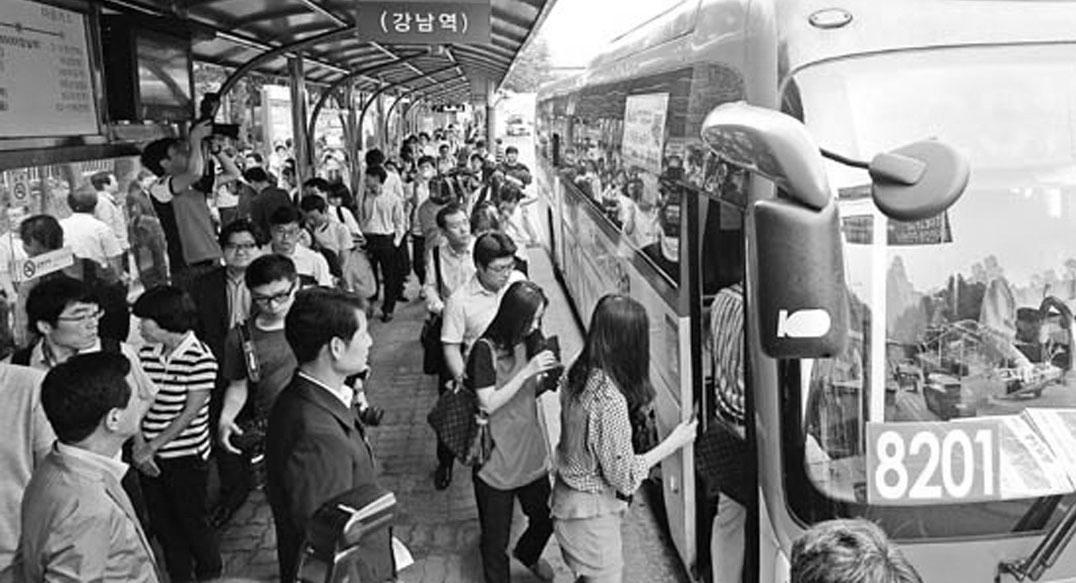 |
||
| ▲ People who were waiting to catch the bus. | ||
Gyeonggi-do has prohibited standing on red buses. Red buses do not guarantee the security of passengers who stand on the bus. After the Sewol ferry accident, the head of local government and officials of the Ministry of Land, Infrastructure and Transport pointed out the dangers of standing on red buses. At the end of their seven meetings, Seoul, Gyeonggi-do, and Incheon City officials announced the prohibition of standing on red buses on June 19. They discussed the potential problems and decided that standing could cause safety issues, so the system was banned in earnest on July 16.
Customers who take the red buses are often office workers commuting between Seoul and Gyeonggi-do or Incheon. They take these buses during high peak hours of congested commuting time, They fill the bus to capacity, often standing on the bus stairs too. However, if there were to be an accident, there is the possibility of a large amount of casualties. The Dankook Herald (DKH) covered the banning of standing on red buses.
Students and workers line up to ride the red buses from dawn. Many people take the buses from Bucheon Terminal. They wait for the bus to come, but they may not even be able to get on, because they are now mostly full. Kim Hyerim (22) said, “I used to be able to get on the bus before six-thirty to get to school. Now I may be late for school because it is after seven,” her experience resulted from the recent ban on standing in buses. “There are even more people on the last red bus. If I don’t get to take the last bus, I won't be able to get home,” she said of the new bus system. Woo Hui-yeong (27) said, The standing ban has been implemented, but there are still buses that have people standing. Some people just get on despite the lack of seats. It’s a problem between the bus driver and them. The prohibition is clearly difficult to enforce.”
The system has many problems. The ban was put in place to ensure the safety of bus passengers, but the resulting system has cause many problems. We are no longer operating buses to their full capacity, so we need to put more vehicles on the road. This leads to greater traffic congestion through the cities as the number of red buses travelling during peak hours has had to increase.
People say the changes should have been implemented only once proper countermeasures were in place. However, going back to permitting standing on buses is problematic. It is illegal to have people standing on red buses that use a motorway or highway. Moreover, in response to the safety movement campaign, after the tragic Sewol sinking accident, the government started to clamp down on standing on red buses during high commuting time beginning in August. Standing on red buses was never safe. Prohibiting this practice is the right thing to do. Research shows that most red buses. Operate at speeds of us to 100km. As a result, the probability of injury for standing passengers during an accident is 19 times higher than normal buses.
There is an inconvenience to commuters of course, but the improvements will result in a safer traffic environment. After witnessing the strong will of the government to ban standing on red buses, the community contributed many ideas to make improvements.
The idea of reinforcing red buses with chartered buses came out a few years ago, but traffic congestion in the heart of the city and the burden of operating costs were the main reasons that chartered buses could not contribute to a
fundamental solution. On the Gyeonggi provincial office webpage, netizen proposed the idea of increasing shuttle bus use for highway travel only. It is a simple strategy. Shuttle buses would stop close to the end of the highway, and allow people to transfer to a local city bus once they disembarked. By increasing the number of intercity buses travelling to and from the stop immediately before and after a highway, we could minimize the increasing number of buses travelling on the motorways and solve safety problems at the same time.
Another citizen proposed an appointment system for booking seats during commuting time. To close loopholes, netizen talked about leaving some seats for the elderly, giving penalties to those who don’t take red bus after reserving a seat, such as a ban on them reserving a bus seat for a week or two. Gyeonggi Province proposed an infrastructure and transportation plan to expand buses from 41 seats to 45 to the Ministry of Land.
“Because there are more buses running on the bus routes, I don’t only have to take 1 extra shift, I have to give up holidays, and take new routes. This makes me feel tense all the time,” Mr Kim said. He worried that the added stress might cause him to drive nervously, putting the passengers’ safety at risk. He pointed out that in order to secure people’s safety, the government should introduce proper countermeasures as soon as possible.
The government's plan has triggered an influx of good ideas from the general public on how to successfully implement this new policy, ones that could satisfy both the government and the people. However, it is a major change in our transportation policy, so the government should introduce radical new measures soon. For now, the government should inform citizens of the nearby subway options or connecting buses.
Once the policy countermeasures are ready, the government should not forget to take the affected people into consideration, and let them know which changes they have made. Definitely, with the implementation of this new system, people are experiencing inconveniences, but rather than just complaining, the people and the government should try to turn evils into blessings, and develop effective remedies for the new red bus policy shortcomings.
Lee Ik-su,Seo Min-ji anhj12261226@gmail.com

![[Campus Magnifier] Let's Surf the Library!](/news/photo/202404/12496_1765_4143.jpg) [Campus Magnifier] Let's Surf the Library!
[Campus Magnifier] Let's Surf the Library!
![[Campus Magnifier] Let's Surf the Library!](/news/thumbnail/202404/12496_1765_4143_v150.jpg)





